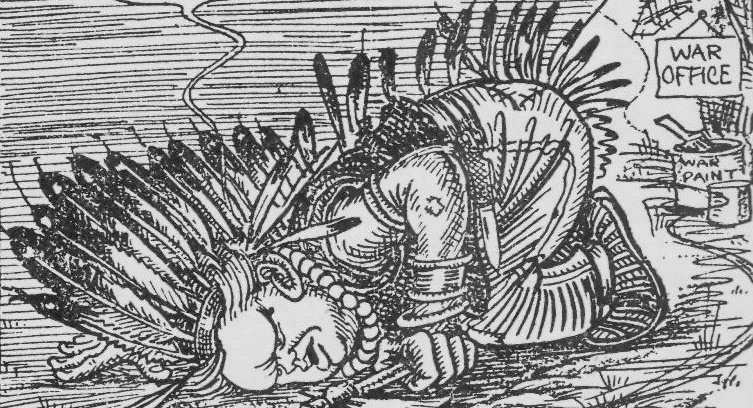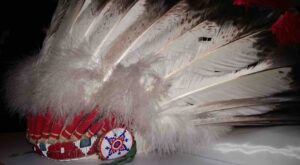
Chief Great Leader: The Myth of Churchill’s Iroquois Ancestors
“Iroquois Ancestors” is excerpted from “The Myth of Churchill’s Native American Forebears,” written for the Hillsdale College Churchill Project. For the original article with endnotes and other images, click here. To subscribe to weekly articles from Hillsdale-Churchill, click here, scroll to bottom, and enter your email in the box “Stay in touch with us.” We never spam you and your identity remains a riddle wrapped in a mystery inside an enigma.
“Chief Great Leader”
Churchill took great pride in his half-American ancestry, through his mother Lady Randolph Churchill, the former Jennie Jerome. The Jeromes were descended from Lt. Reuben Murray, who fought in Washington’s army.
Sir Winston further embellished his American connection by repeating a family legend that Iroquois blood ran in his veins. This Churchill myth arose from family stories before he was born. It was the prologue to scores of fables that surrounded Churchill in life.
In 1960, Sir Winston told one of his doctors that he was descended from a Seneca mother. The Seneca were the farthest western branch of the Iroquois people. Before the American Revolution they lived south of Lake Ontario, within the Six Nations or Iroquois League. Thus, wrote Robert Pilpel, “the quintessential Englishman was not only half-American but also one-sixty-fourth Native American.”
“Ba-ja-bar-son-dey”

On 2 November 1963, based largely on his claim, the National Congress of American Indians made Churchill a chief. They named him “Ba-ja-bar-son-dey,” meaning “Great Leader of Men.” They presented him with the full regalia of a Sioux chief, allegedly been worn in battle. It had belonged (ironically enough) to Chief White Man of the Brulé Sioux, part of the Lakota tribe in South Dakota.
“The tunic was decorated with the scalps of enemies killed in battle and the trousers, made of buffalo hide, were marked with bloodstains,” wrote Roy Howells, Churchill’s nurse in his later years: “The huge feathered war headdress was very heavy and decorated round the band with coloured beads.” Despite his partiality to exotic headgear, we have no indication that WSC ever wore it.
An examination of the items, carefully preserved at Chartwell, disclosed strands of attached black hair possibly from scalps, but only a few droplets of what Howells thought was blood: Chief White Man was evidently a fastidious scalper.
Family lore
The early Churchills believed that Iroquois blood had been introduced into Churchill’s family through Jennie Jerome’s maternal grandmother, Clarissa Willcox. Like Jennie, Clarissa had a pronounced dark complexion. It is quite possible that other children, confronted with Clarissa’s visage, teased and even convinced her that she was in part Native American.
Randolph Churchill, like his sisters, accepted the Native American story. In the Official Biography he wrote that Clarissa was “the grand-daughter of Eleazur Smith, of Dartmouth, Massachusetts, and Meribah (no maiden name recorded), who is believed to have been an Iroquois Indian.” This may have been the origin of the “Seneca” his father mentioned.
Genealogical reality
The Churchill genealogist Elizabeth Snell cut through all this two decades ago, revealing that Meribah was neither Clarissa Willcox’s mother nor an Iroquois woman. She was the daughter of Benjamin and Sarah (Tompkins) Gifford, born in Dartmouth, Massachusetts on 30 June 1722. Snell also identified Anna Baker’s mother, and her background, thanks to a 1951 typescript on the descendants of the Baker family.
Anna Baker was the daughter of colonial Americans, Joseph Baker and Experience Martin, who married in Swansea, Massachusetts in 1760. In 1761 the Bakers and other family members moved to Sackville, Nova Scotia, where Anna was born and lived until 1787. Later the family returned to New England. “The ancestry of Joseph Baker,” Snell wrote, “is well documented.” It is possible that the men of Anna’s family were soldiers at the time of her birth.
The Bakers returned to Massachusetts in 1787, where Anna married David Willcox of Dartmouth. By 1791, Snell continues, the couple had moved to Palmyra, in northern New York, where Willcox purchased a 100-acre farm and set up a blacksmith shop. Their home was still extant in 1970, when Anita Leslie, grand-niece of Jennie Jerome, visited Palmyra to promote her book, Lady Randolph Churchill.
Clarissa Willcox
Anna Baker Willcox’s daughter Clarissa was born 30 September 1796. David and Anna Willcox are buried together in Palmyra, where their headstones may still be seen. Anna’s father, Joseph Baker, died 15 June 1796. In his will he named his daughter, “Anne Willcocks.”
As for the conjecture that Clarissa Willcox was the result of an encounter with an Iroquois, Snell wrote: “There were no Iroquois in Nova Scotia, where Anna spent much of her young womanhood. While there were certainly Iroquois in upper New York state, where she moved as a 25-year-old wife and mother, her husband’s will mentions their daughter ‘Clarind Willcox’ and her sisters, which in itself seems definitive.”
Which story is more believable? Was Clarissa an illegitimate half-Iroquois, brought up by the Willcox family as a daughter? Or should we accept, as Snell did, “the simple, forthright facts as recorded by her colonial family in their probate records”? The absence of proof does not make a story untrue; but it does not establish it, either.
The myth continues
Without any evidence we are left only with family legends, passed along through the generations. Clarissa Willcox’s daughter Clarissa or “Clara” (1825-1895) married Leonard Jerome (1817-1891) in 1849. Jennie, the future Lady Randolph (1854-1921) was the second of their four daughters. In 1874 she married Lord Randolph Churchill, and the rest is history—not without continued claims of Iroquois ancestry.
All the “writing Leslies”—descendants of Jennie’s sister Leonie—accepted the story of Native American ancestors. Shane Leslie, WSC’s cousin, believed it. So did his daughter Anita, who cited “half-hushed rumors concerning her Indian blood…. Clara knew herself to be a quarter Iroquois.”
The myth was passed along. Churchill’s daughter, Lady Soames, certainly believed it, until confronted with the facts—as did her children. She once told me: “I remember my daughter Emma, playing with her mates at Chartwell Farm. Suddenly I heard her warn them not to misbehave: ‘My Mama, you know, is part red Indian, and if we are naughty she will go on the war-path.'”
This vision was apparently enough to prevent any hijinks by Emma’s youthful companions.
Randolph elaborates
Churchill’s son Randolph actually embroidered the story. Landing once in Johannesburg, Randolph was incensed by an immigration form asking him to declare his race—required in the time of Apartheid. “Damned cheek!,” exclaimed Randolph, who began writing furiously:
Race: human. But if, as I imagine is the case, the object of this enquiry is to determine whether I have coloured blood in my veins, I am most happy to be able to inform you that I do, indeed, so have. This is derived from one of my most revered ancestors, the Indian Princess Pocahontas, of whom you may not have heard, but who was married to a Jamestown settler named John Rolfe.
And on it goes…
Sir Winston’s grandson Winston loved the tale: “For me,” he insisted, “physical features speak louder than any entry in a register of births.” In the introduction to a collection of his grandfather’s writings on America he wrote: “According to family tradition, Jennie’s maternal grandmother, Clarisse Wilcox [sic], was half Iroquois.”14
During his accompanying book tour, my wife and I drove Winston to Plimoth Patuxet, formerly Plimoth Plantation, Massachusetts, where the Mayflower landed in 1620. There he encountered a Native American (or a staffer posing as one). He greeted him by suggesting they might be related.
In the car later I could not help tweaking him: “Winston, you are as Iroquois as my cat.” He grinned and said, “It’s my story and I’m sticking to it.”
The Native American story deserves pride of place in any catalogue of Churchill falsities. It illustrates how, hoping to embellish the saga, some Churchills and various writers seized on legends unsupported by facts. Alas many tall tales that followed this one were less innocent.
Tribal hostilities
Below: The first of two cartoons depicting WSC in Native American regalia (left, about to stab an opponent). Skirmishing in the foreground and definitely identified: Prime Minister H.H. Asquith and Conservative Leader Arthur Balfour. Back row: Austen Chamberlain, David Lloyd George, The Earl of Crewe, John Redmond, Richard Haldane, John Morley and Reginald McKenna. We are undecided about Churchill’s opponent in the knife fight, varying between F.E. Smith, Sir Edward Carson, or Edward Grey.

Related articles
“Pocahontas: Randolph Churchill’s Jibe at the Race Question,” 2020.
“American Jennie and Other Books on Lady Randolph Churchill,” 2020
“Winston S. Churchill 19409-2020,” 2020.
“Present at the Creation: Randolph Churchill and the Official Biography, Part 1,” 2019.






